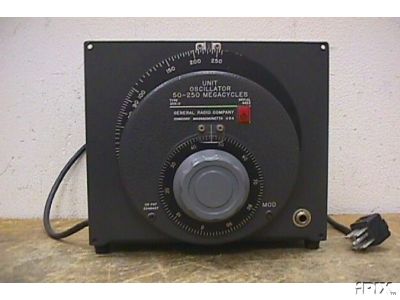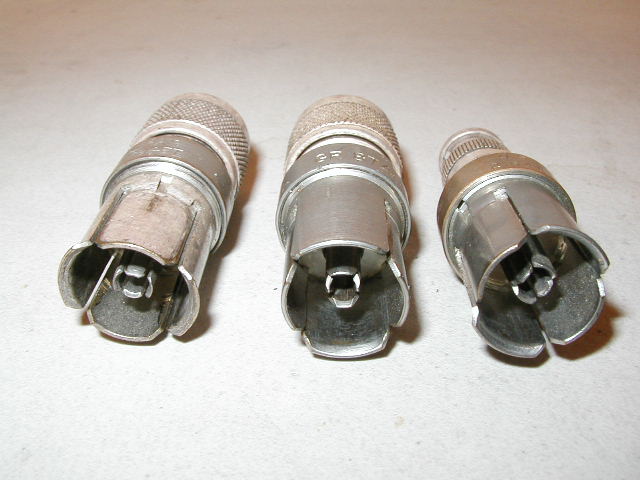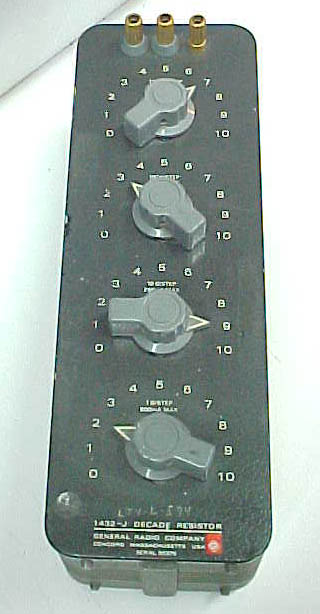 General Radio
General Radio General Radio
General Radio
Here's some additional history I've found:
GR had an interesting philosophy of making instruments that were more modular than HP offerings. On the left is the popular HP 608 signal generator, which covered from 10 to 480 MHz in one unit. It had a zillion tubes, weighed a ton, and cost thousands. On the right is a GR "Unit Oscillator". GR had a series of these, each of which had one tube and one band, and was small and light and less expensive. However if you wanted modulation or leveling or buffering you had to add that on, and you would need three different unit oscillators to cover 10-480 MHz.

|

|
In fairness, the unit oscillators were not mainly intended for duty as a "signal generator" for receiver testing like the HP 608. They were more often used as a local oscillator or signal source for an RF bridge, or often as a part of some special test setup where the features (and cost) of a signal generator were not needed. However, you could build a signal generator by adding on an attenuator, modulation source and special leveling power supply.

This is another view of the end of an 874 connector, see how by rotating the connector 90 degrees, it will mate with itself:

Delta RF makes and sells adapters from GR-874 to other types.
GR had a components business even before they got into instruments. GR made the variable capacitors that Edwin Armstrong used when he invented the first superhetrodyne receiver in 1917. Most noteworthy are GR's instrument-grade rotary switches, potentiometers and precision capacitors and resistors. GR made a good business out of putting their resistors and capacitors in boxes along with their switches (making decade boxes.) The switch is the heart of a precision resistor decade.

Another component that GR made in house was transformers. They are massive, efficient, and distinctive in appearance. GR was also creative in transformer design, inventing the Variac variable autotransformer, which is still widely used for power supply testing:

The finesse is a little harder to explain, but part of it was due their ability to make custom components in-house. One of the most artful hacks I've seen is in the in the GR 1211-B unit oscillator which covers 500kHz to 50Mhz in two decade bands. Usually in a tuned LC tank, bands are narrower than 10x, since they are tuned by varying the capacitor, and a 10x range would require a 100x capacitance change, which is not practical. The 1211 does this by simultaneously varying both the inductance and the capacitance. The inductance is varied by rotating a carefully sickle-shaped composite of powdered iron and aluminum through the tank coil. Now, the use of a movable slug of either iron or copper to tune an inductor was common, but it was rarely done for a front-panel control. But I have never seen anywhere else either the use of a composite slug, or the peculiar mechanical arrangement for circular motion of the slug.
What really staggered me, though, was how the band switching was done. Recall that I said the unit oscillators usually had only one band. The 1211 does have two bands, and the switching is done by a funny lever on the front. This is indeed a switch, but if you look inside, it works more by rotating the instrument around the contacts than by moving contacts past each other. The effect is to install the HF coil in the same mechanical position on the tuning slug that the LF coil was previously in.
All this control weirdness was simply not how things were done at other instrument companies. They bought their variable capacitors from component manufacturers. They may have had them custom built, but the variation was just in terms of the capacity, number of gangs, etc. They didn't design weird controls and then wrap an instrument around them. GR instruments are anomalous engineering artifacts because they are often so highly optimized. They aren't just assemblages of standard components, the components were designed as integral parts of the instrument.
I am also impressed with the GR 1205-B Adjustable Regulated Power Supply. This supplies 200ma of regulated power from 0-300V, which is 60W. This a good bit of power to be controlling with a handful of tubes in a unit that small. It is pretty dense because about 1/4 of the volume is taken up by a massive GR transformer. The secret to the power handing is it is not a purely linear regulator. It uses a pair of thyratrons (a tube SCR analog) as a phase control pre-regulator. That way, the output tubes only have to drop 25V or so to maintain regulation, and don't melt. Also, the regulator uses various clever hacks for better line and load regulation. In addition to the classic hack of biasing the reference device from a regulated output derived from the reference, the error amplifier also makes direct use of positive feedback to boost the gain. With tubes, each additional tube had significant costs in size, price and reliability, so people really sweated to squeeze all they could out of a few active devices.
C PetersonIf you have any GR related info, I'd be happy to add it to this page.